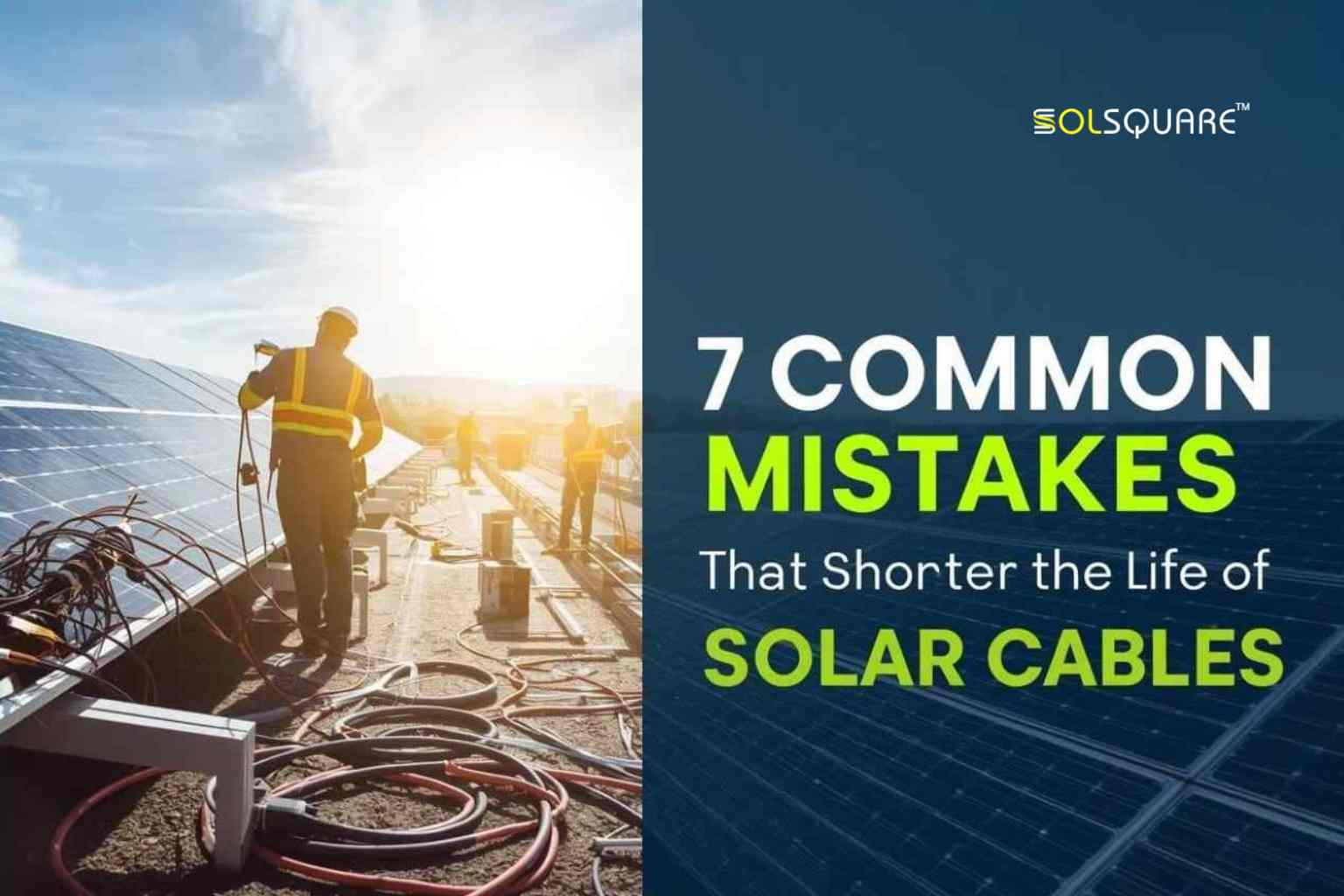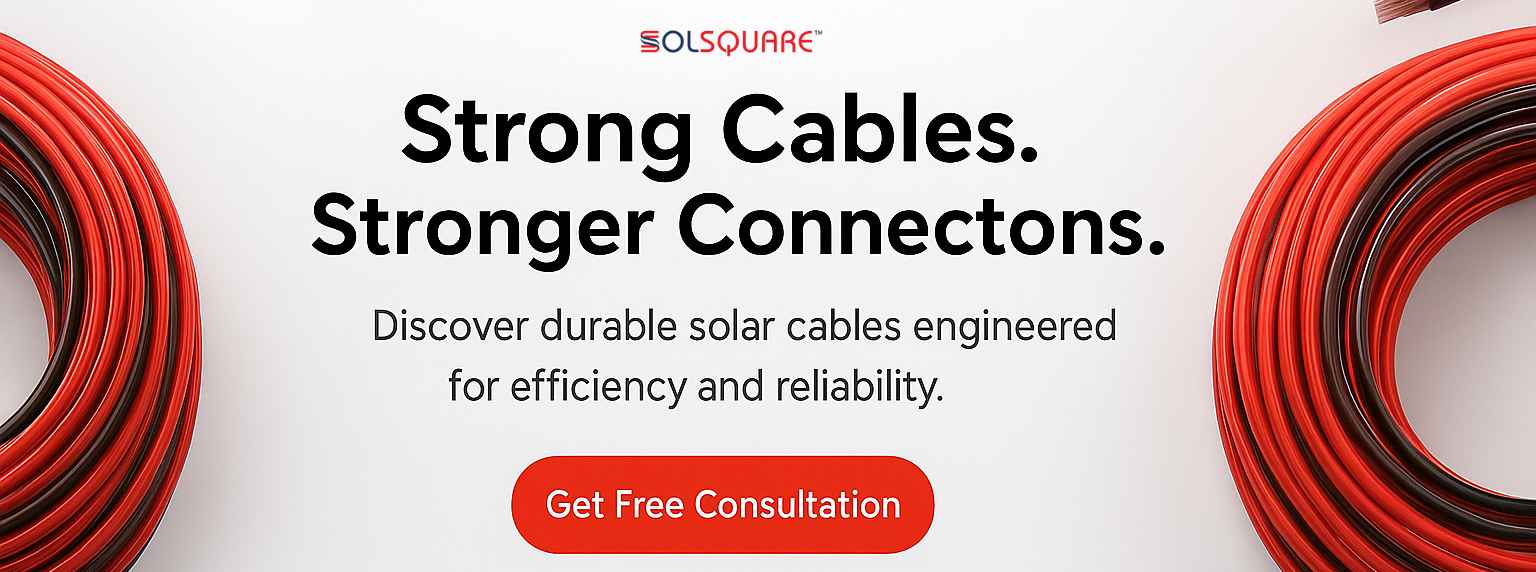7 Common Mistakes That Shorten the Life of Solar Cables - and How to Prevent Them
Discover the most common installation and maintenance errors that reduce the lifespan of solar cables - and learn how to prevent them effectively.

Solar power solutions are built to be functional over a long time - however their dependability is quite a steep drop down from the smallest parts most notably from solar cables. These wires are the core of your solar setup: they are the means through which the power produced by your panels is flowing. For a long time, as a rule of thumb, many solar installations suffer from lowered performance or even premature failure as a result of an incorrect choice, installation, or maintenance of the cable which could have been easily prevented.
1. Using Low-Quality or Non-Certified Cables
The Mistake:
Many installers or buyers try to cut costs by choosing cheaper, uncertified solar cables. Probably these wires are missing some proper UV resistance, weatherproofing, or insulation thickness - which are all very important for the cable to work well over a long period.
Why is it a problem:
Uncertified cables will become very fast their enemy is the sun, the temperature changes, and the humidity. Over time the cable will crack in the outer sheath, there will be energy losses and the short circuit risk will increase.
What you can do to remove it:
Be certain that the solar cables you are employing conform to the IEC 62930 or TUV 2PfG 1169 standards.
Cables should be free from UV and halogen effects.
Purchasing from reputable manufacturers who provide you with certification documents and warranty coverage is a good idea.
Professional tip: Premium cable might slightly increase the initial cost of the project but will result in higher reliability and lower replacement costs during the lifetime of the project.
2. Incorrect Cable Sizing and Current Rating
The Mistake:
Thin cables that are used for a system's current load seem to be one of the most frequently misunderstood problems that have been simply ignored. The situations where the installers wrongly estimate the current flow or the cross-sectional area of the wire is that they use cables of different sizes are very frequent.
Why It's a Problem:
Voltage drops, overheating, and power losses are some of the effects that can be caused by undersized cables. Insulation can even melt if the excessive heat that is generated over time is allowed to continue, or the connectors can suffer damages - thus, premature cable failure is the result.
How to Prevent It:
Make sure that you perform the cable sizing calculation correctly based on the current, voltage, and distance.
You can use online solar cable sizing calculators or see the manufacturer's charts for your help.
Allow for a safety margin of at least 10-15% when selecting your cable, always going above the calculated requirement.
Example: If the system is to be wired with 6mm² cables, it is better to choose an 8mm² one for better performance and longer service life.
3. Poor Cable Routing and Sharp Bends
The Mistake:
Improper routing - such as forcing cables around tight corners, sharp edges, or metal structures - can lead to physical stress and insulation wear.
Why It's a Problem:
Sharp bends or areas of high tension in insulation can cause micro-cracks which, if the product is subjected to vibration and weather over time, can become larger. These situations can lead to short circuits, grounding faults, and may even cause a fire hazard.
Preventing the Folding of the Wire Insulation:
The radius of the bend should be no less than 4-6 times the cable diameter.
Besides cable clips holding the cables firmly and tightly, conduits or trays can also be used to both support and protect the cables from the edges.
Ensure that cables are far from the components that produce high heat and parts that are moving.
Tip: Proper cable management that is tidy and organized not only enhances the safety aspect but also makes the work of maintenance easier.

4. Inadequate UV and Weather Protection
The Mistake:
Throughout the years, solar cables are left to be under direct sun rays, rain, and wind. Moreover, some installers neglect the fact that the cables should be UV-stabilized and weather-resistant for outdoor use.
Why It's a Problem:
The sun rays and water cause the insulating material to become cracked, to harden, or even to peel. The corrosion of the copper conductor increases the electrical resistance of the system and a failure is more likely to happen.
How to Prevent It:
Opt for UV-resistant cross-linked polyethylene (XLPE) or polyolefin-insulated solar cables.
Firstly, cover any exposed cables with UV-resistant conduits or cable trays. Secondly, do the check-ups regularly, e.g., annually, in order to be sure that you can always see the surface in the fading or you can confirm the lack of cracks or brittleness.
Bonus Tip: Avoid water and rodent harm by providing connectors with air.
5. Loose or Improper Connections
The Mistake:
There is a great risk that even the best cables might become inoperative. The most eminent reason for this is the improper or loose crimping of connectors. If incompatible connectors (for instance, MC4 of different brands) are mixed, this matter will be even worse.
Why It's a Problem:
The term "loose connections" describes a situation where resistance heating, arcing, and thus connector melting or fire hazards might occur. Also, electrical losses increase, and the system's efficiency is lowered significantly.
How to Prevent It:
In the very first place, try to use connectors that are compatible and from the same manufacturer.
It is also very important that your crimping tools are properly calibrated and that you are using them in the correct manner.
After the mouting, perform torque tests and visual inspections.
Regularly inspect the condition of your connections during the maintenance period.
Pro insight: One of the primary reasons for the early solar cable degradation is poor crimping.
6. Neglecting Thermal Expansion and Mechanical Stress
The Mistake:
The temperature of solar arrays changes as well as their surfaces. Therefore, the solar cables should not be fixed tightly or without room for thermal expansion and movement of the solar cables.
Why Its a Problem:
If the cable joints keep on getting pushed and pulled with the changes of the insulation in those cable joints as a result of the temperature changes, then the cable joints will be damaged and connections will be loosened substantially over time without the intervention of humans, especially in outdoor places with large temperature differences.
How to Prevent It:
One should not tighten the cable too much but should allow a small slack or loop of the cable to accommodate thermal expansion.
The solar cables should be flexible to allow for the movement and vibration of the installation.
Do not over-tighten the cable ties — instead, use UV-resistant, flexible ones.
7. Ignoring Maintenance and Periodic Inspections
The Mistake:
The owners of the solar system usually think that it is not necessary to inspect the cables once the system has been installed, hence they do not carry out any inspections.
Why It's a Problem:
Without proper upkeep, the gradual major decrease in the performance of the cable caused by environmental stress, rodents, and the aging process is inevitable. The absence of any maintenance issues makes the small issues unnoticeable until serious system failures result from them.
How to Prevent It:
Conduct quarterly or annual visual inspections of the system for any defects such as cracks, corrosion, or discoloration.
Insulation resistance should be monitored regularly by a megohmmeter test.
Remove and shorten the replacement of the connectors or cables when they are worn out or damaged.
Use maintenance logs to keep track of your system's performance over time.
Never forget: regular inspection can not only save a great deal of cable replacements but also allow these cables to be operational for several more years.
Best Practices for Long-Lasting Solar Cables
Solar power modules can keep running safe and power-efficient for a few decades, provided the following measures are taken:
- By using first-class, certified solar cables that are designed to withstand UV radiation and are weather-resistant.
- Proper routing, supporting, and maintaining the correct bend radius of the cables.
- The cleaning and inspection of the solar cables on a regular basis.
- Excellent connectors and tools.
- Recording precise wire details and writing down the installation information in case of a warranty claim in the future.
By following these rules, your solar installation will not only be safe, but you will also get better efficiency and lower maintenance costs in the long run.
FAQs
Conclusion
Solar cables can be considered a minor fraction of your green energy system, however, without them the whole system wouldn't be safe, efficient and long-lasting. Errors that try to cut short their life such as wrongly sizing and not maintaining them, can all be avoided if one has the right knowledge and follows the correct practices.
If you want to be able to enjoy your system for a long time with as few stops as possible, you should put money into good quality cables, strictly follow the installation standards and be devoted to carrying out regular inspections. This will reduce losses and guarantee the excellent performance of your solar power plant over a long period of time.